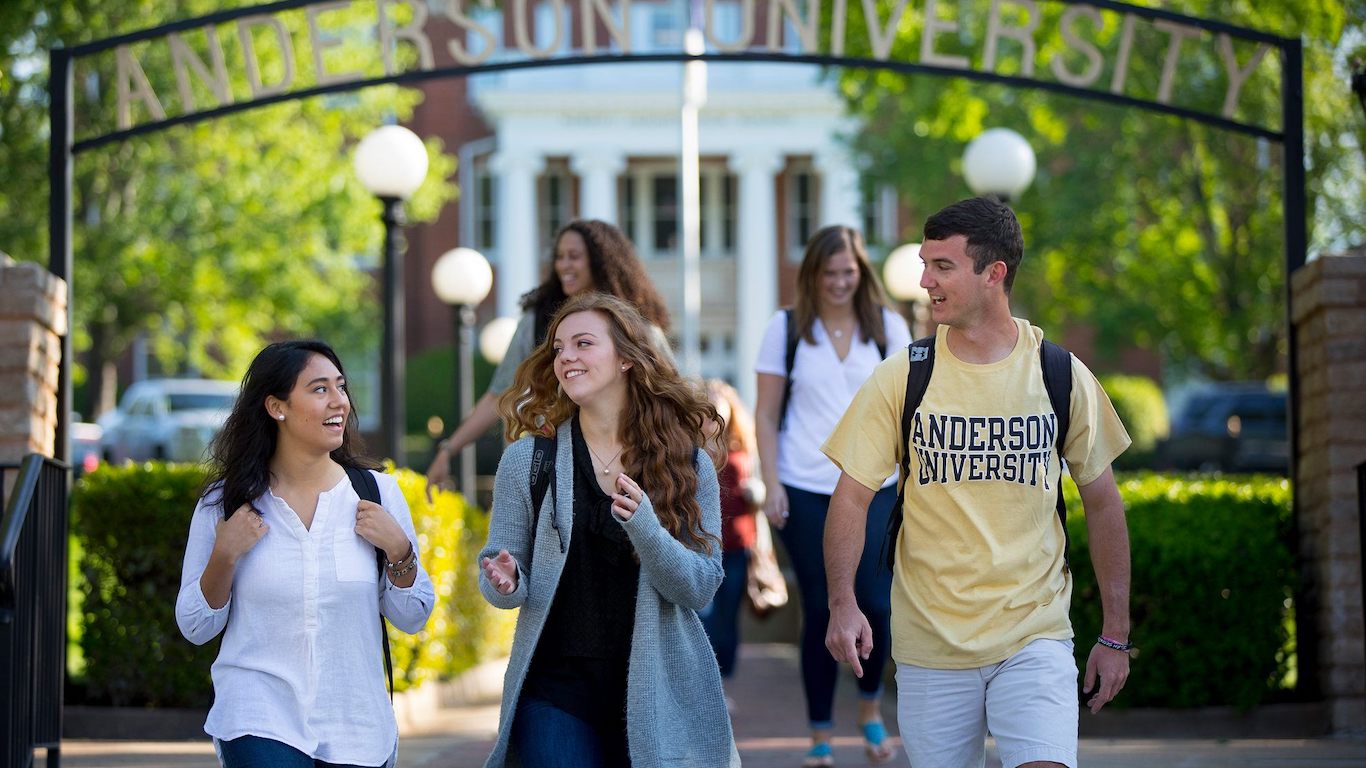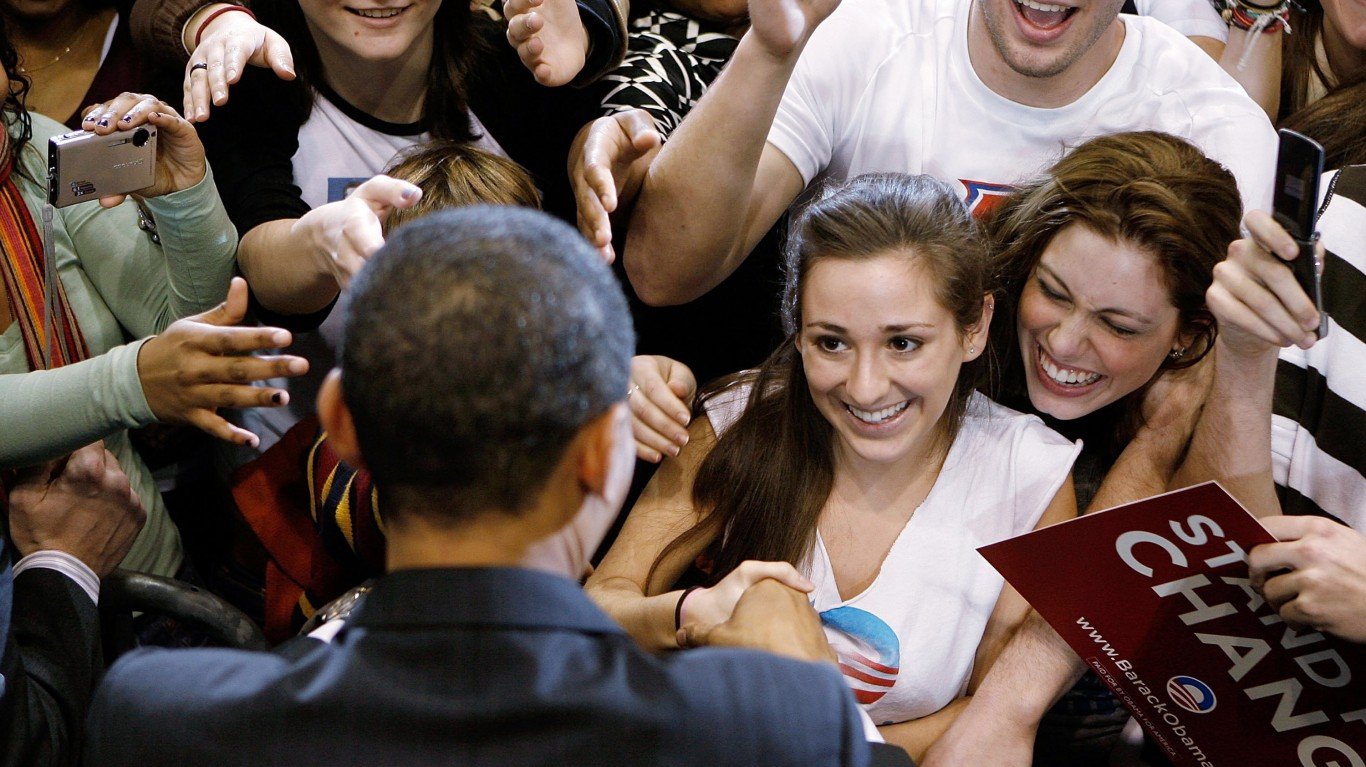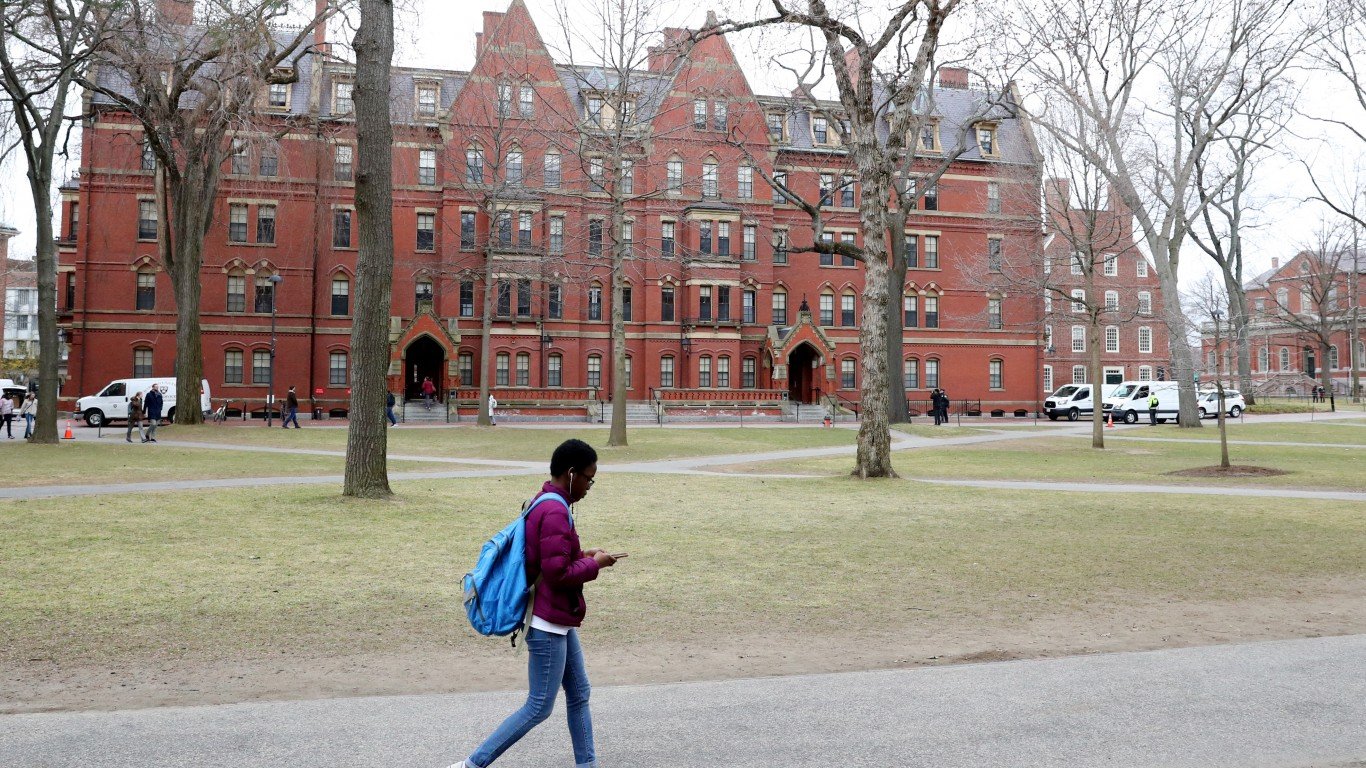

In the 2020 presidential election, college graduates preferred Joe Biden to Donald Trump by a 55%-42% margin, according to University of Virginia exit polls.
Students who are attending college tend to skew left as well, in general, as younger people tend to also be more liberal. Still, some college campuses stand out as farther left than others, with students much more likely to identify as a Democrat than a Republican and feel that their peers identify the same way.
To determine the most liberal colleges in America, 24/7 Wall St. reviewed data from education data clearinghouse Niche’s “2021 Most Liberal Colleges in America” list.
Nearly every college on this list is located in a state that tends to vote Democrats over Republicans in state elections. These states are generally either on the West Coast or in the Northeast.
Though college campuses tend to have more liberal than conservative students, there are still a number of schools in America in which the vast majority of students have conservative ideologies. Many of these schools are private institutions with religious affiliations. These are the most conservative colleges in America.
Nearly every college that ranks among the most liberal in the country is more expensive to attend than the typical U.S. college, and half of the 20 schools have average annual costs over $63,000 — ranking them in the top 200 most expensive colleges out of over 6,800 institutions. This is the most expensive college in every state.
Click here to see the 20 most liberal colleges in America.
Click here to read our detailed methodology.

20. Colorado College
> Location: Colorado Springs, CO
> Avg. annual cost of attendance: $68,532
> Typical earnings 10 yrs. after enrollment: $45,400
> Most popular undergrad major: Economics
Colorado College in Colorado Springs is one of the most liberal colleges in the country. According to a survey from educational information hub Niche, 63% of students associate themselves with the Democratic Party, while just 11% associate with the Republican Party.
Colorado College is one of the most selective schools in the country, accepting just 13.5% of applicants. It is also the smallest school on this list with fewer than 2,100 enrolled students as of fall 2018
[in-text-ad]
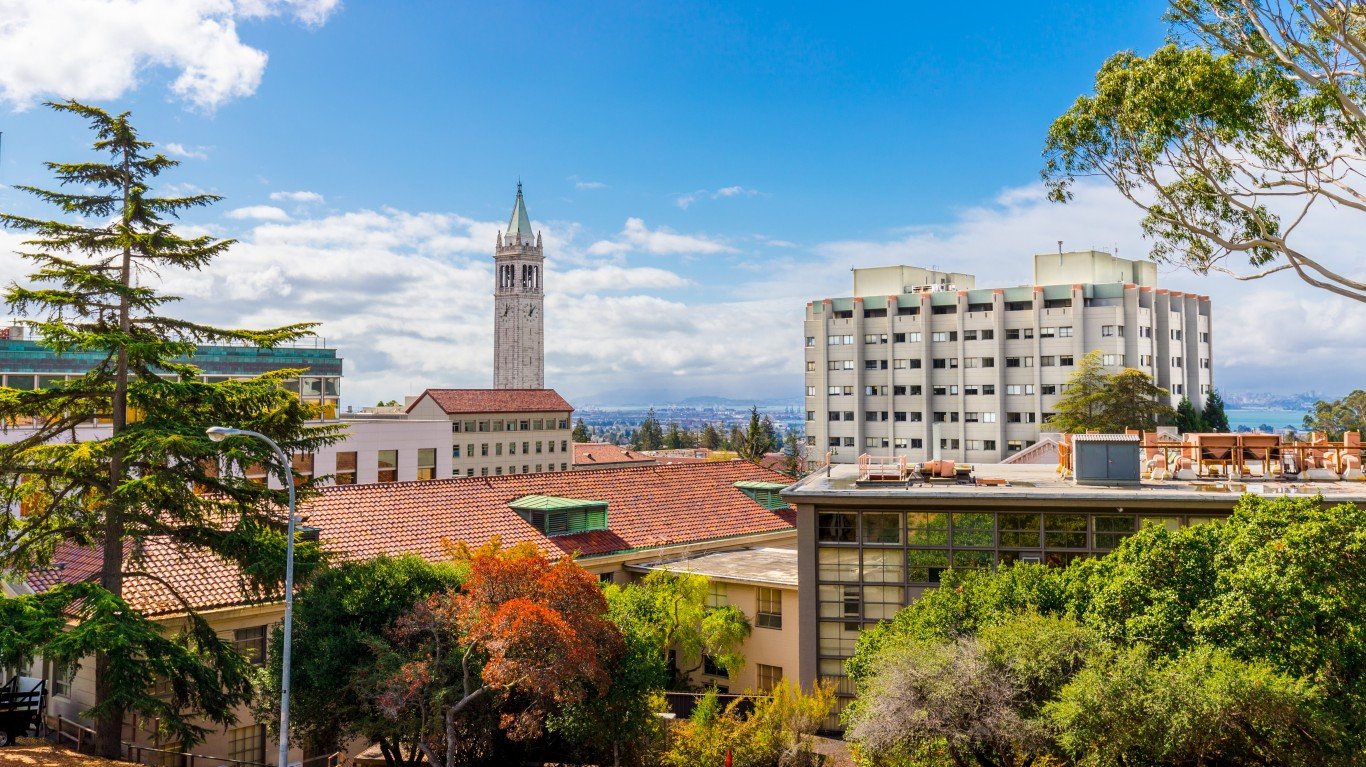
19. University of California-Berkeley
> Location: Berkeley, CA
> Avg. annual cost of attendance: $36,739
> Typical earnings 10 yrs. after enrollment: $64,700
> Most popular undergrad major: Economics
The University of California-Berkeley, sometimes shortened to Cal or Cal Berkeley, is one of the most liberal colleges in the country. Per Niche, 84% of students describe the political climate on the campus as either liberal or very liberal.
Cal Berkeley has a long history of left-wing activism, with students famously advocating for racial parity in the 1960s. In 2017, the school again made news when students and other protesters disrupted a planned speaking engagement by Milo Yiannopoulos, who at the time was the editor of right-wing Breitbart News.
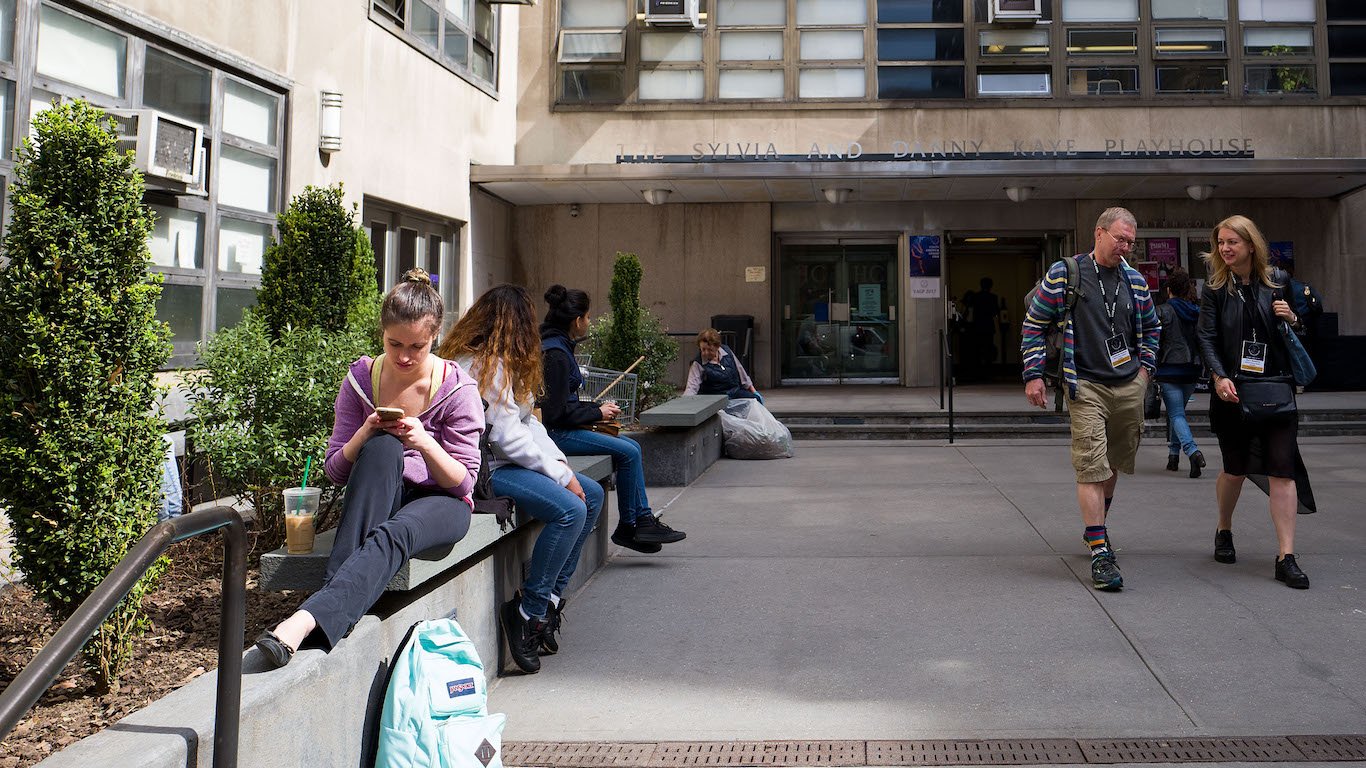
18. CUNY Hunter College
> Location: New York, NY
> Avg. annual cost of attendance: $13,998
> Typical earnings 10 yrs. after enrollment: $47,200
> Most popular undergrad major: Psychology, general
CUNY Hunter College is one of three New York City colleges to rank among the most liberal in the country. CUNY Hunter College is located in the Lenox Hill neighborhood on New York City’s Upper East Side. Just 5% of Niche user students that they associated themselves with the Republican Party, compared to 45% aligning with the Democratic party, and 35% saying they are not politically inclined.
CUNY Hunter College students tend to be financially successful after school. Most students who are working and not in school 10 years after entering CUNY Hunter earn over $47,000 per year, a higher figure than in the vast majority of other colleges. The comparable median earnings nationwide is just over $33,000.
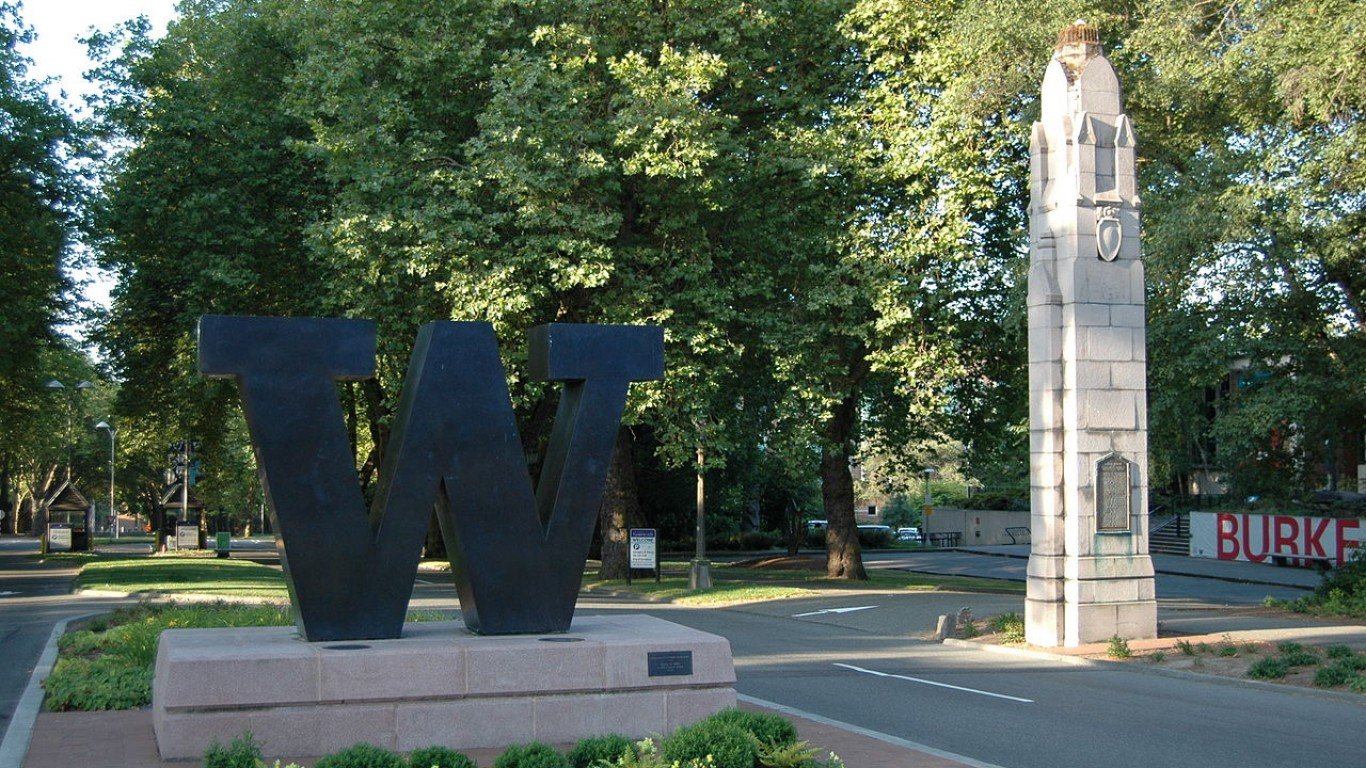
17. University of Washington-Seattle
> Location: Seattle, WA
> Avg. annual cost of attendance: $25,275
> Typical earnings 10 yrs. after enrollment: $57,700
> Most popular undergrad major: Communication and media studies
The University of Washington flagship Seattle campus is one of several large state schools to rank among the most liberal colleges in America. There is little debate among students that the overall political tenor of the school is more liberal. In a Niche survey, 50% of students said the campus was liberal, and 23% said it was very liberal. Just 1% felt the campus was conservative.
In addition to being one of the most liberal colleges, UW-Seattle is also one of the most racially diverse. Less than 40% of students identify as white alone, while 22% are Asian, 7% Hispanic, and 6% multiracial.
[in-text-ad-2]
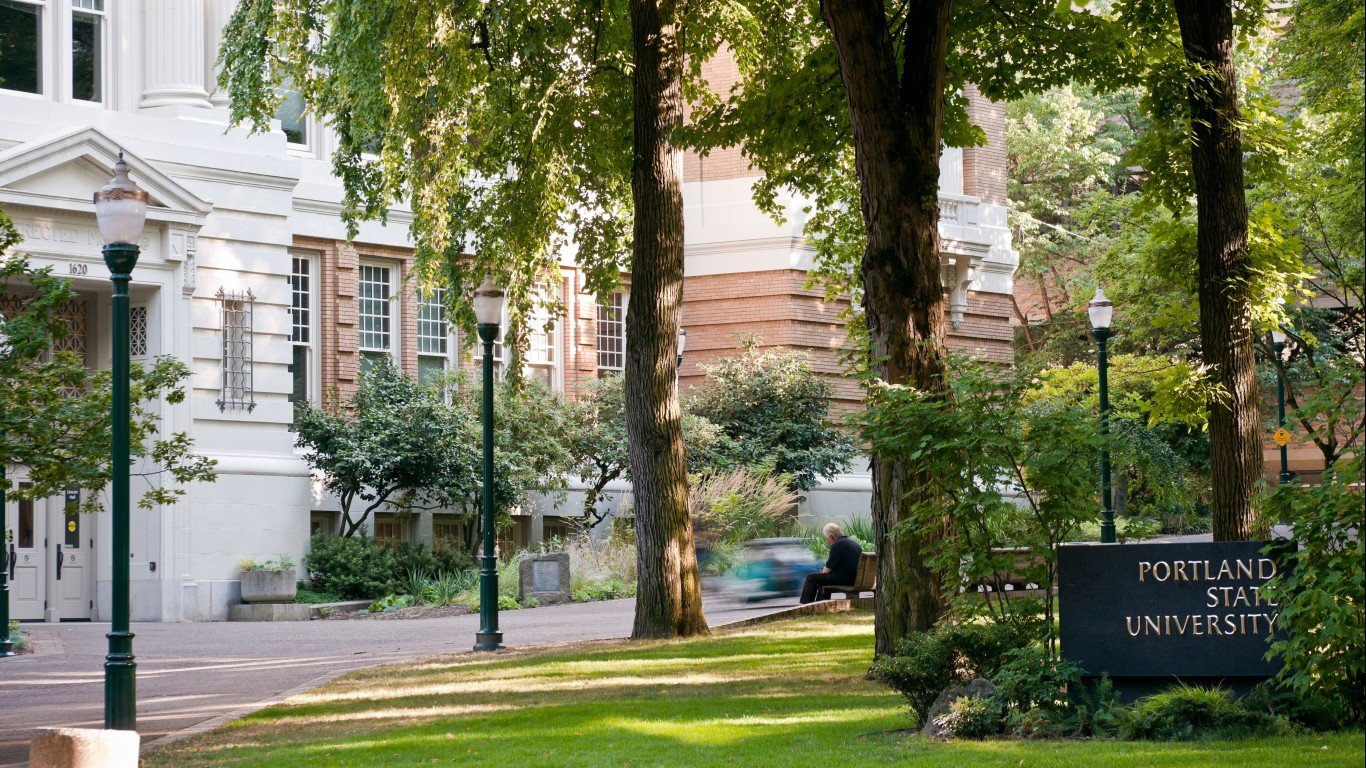
16. Portland State University
> Location: Portland, OR
> Avg. annual cost of attendance: $21,159
> Typical earnings 10 yrs. after enrollment: $44,700
> Most popular undergrad major: Business administration, management and operations
Just 1% of Portland State University students feel the political beliefs of the campus as a whole are conservative, according to Niche. The same share feel the PSU campus is libertarian. On the other hand, 78% of students feel the campus is either liberal or very liberal.
Portland State has produced a number of Democratic politicians, including Oregon State Representatives Teresa Alonso León and Diego Hernandez, as well as Barbara Roberts, who became the first woman governor of Oregon when she was elected in 1991.
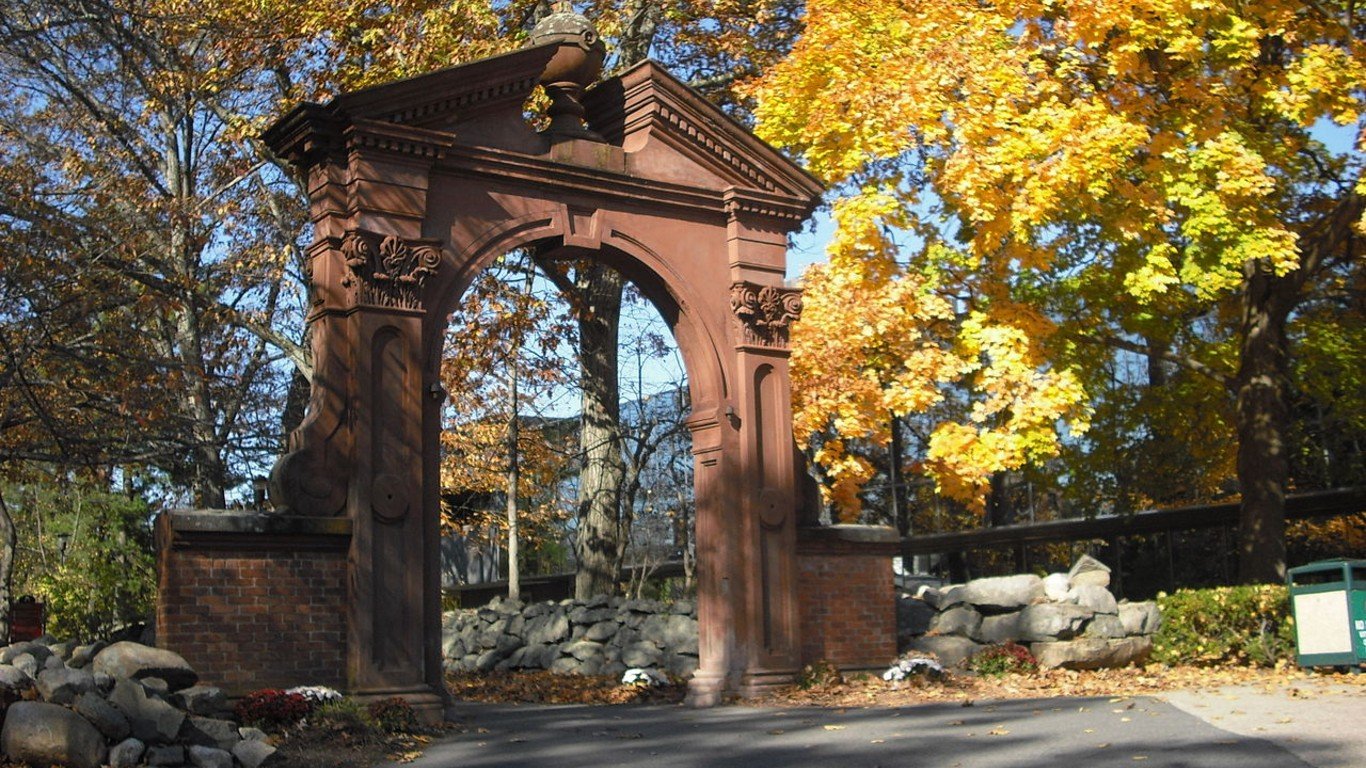
15. Ramapo College of New Jersey
> Location: Mahwah, NJ
> Avg. annual cost of attendance: $27,907
> Typical earnings 10 yrs. after enrollment: $53,200
> Most popular undergrad major: Business administration, management and operations
Per a Niche survey, students at Ramapo College of New Jersey identify more with the Democratic Party than the Republican Party by a 47%-6% split. The remaining students either describe themselves as independent or as not interested in politics.
Ramapo College is one of the newest institutions on this list, having been founded in 1969. Like many other colleges on this list, its most popular undergraduate major is business related — business administration, management and operations.
[in-text-ad]
14. Denison University
> Location: Granville, OH
> Avg. annual cost of attendance: $64,935
> Typical earnings 10 yrs. after enrollment: $48,800
> Most popular undergrad major: Economics
At Denison University, 57% of students saying they identify with the Democratic Party, according to a Niche survey, compared to just 7% who align with Republicans. Located in Granville, Ohio, Denison is one of just two schools on this list located in a state won by Republican Donald Trump in the 2020 presidential election.
Denison University students tend to be financially well-off after leaving school. A decade after entering the college, 94.6% of attendees are employed — one of the 30 highest employment rates out of over 4,000 U.S. colleges. Also, students in the workforce and not in school 10 years after entering Denison University have a median income of $48,800, well above the national median of just over $33,000.
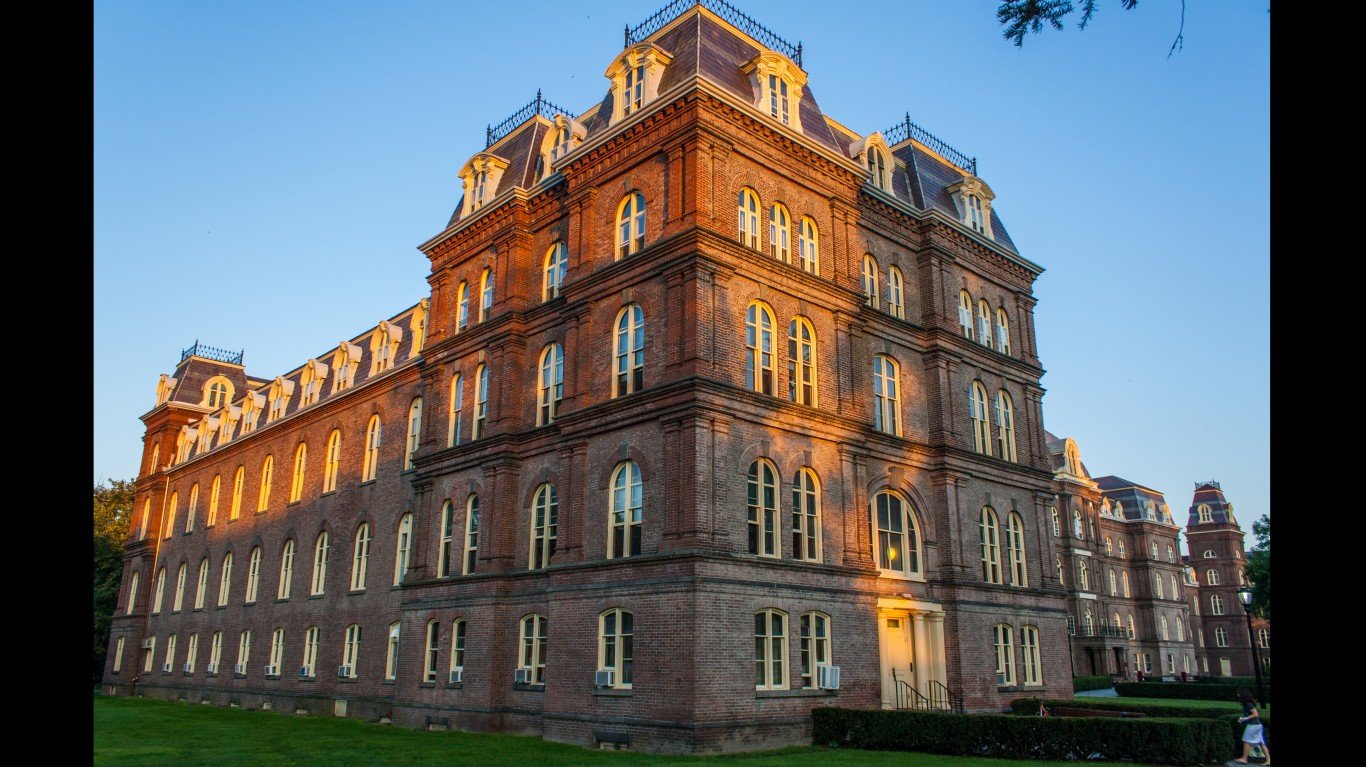
13. Vassar College
> Location: Poughkeepsie, NY
> Avg. annual cost of attendance: $70,900
> Typical earnings 10 yrs. after enrollment: $54,600
> Most popular undergrad major: Economics
Vassar College is a small, private liberal arts institution located in Poughkeepsie, New York. Among students at Vassar, 15% feel the campus’s political beliefs skew very liberal and an additional 82% feel the campus is very liberal. Vassar is one of the Seven Sisters Colleges — elite schools founded for women when they were not allowed into Ivy League schools. Though men can now attend Vassar, women still comprise the majority of the student body. It is one of two Seven Sisters schools on this list.
Women have historically leaned left, and the gap has grown more pronounced in recent years. In 1994, more women identified as Democrats or leaned towards the Democratic Party than the Republican Partyby a 48%-42% split, per a Pew Research Center survey. By 2019, that gap widened to 56%-38%.
12. Barnard College
> Location: New York, NY
> Avg. annual cost of attendance: $71,071
> Typical earnings 10 yrs. after enrollment: $57,900
> Most popular undergrad major: Economics
At Barnard College, located in the Upper West Side of Manhattan, 90% of students feel the political beliefs on campus are either liberal or very liberal.
Many of the schools on this list are very prestigious, having a longstanding history of providing a quality education. These schools, because of their reputation and high number of high schoolers who would like to attend them, admit a fraction of applicants and can charge relatively high tuitions. Barnard College is no exception, with the average annual cost of attendance exceeding $71,000, one of the 25 highest figures in the nation.
[in-text-ad-2]
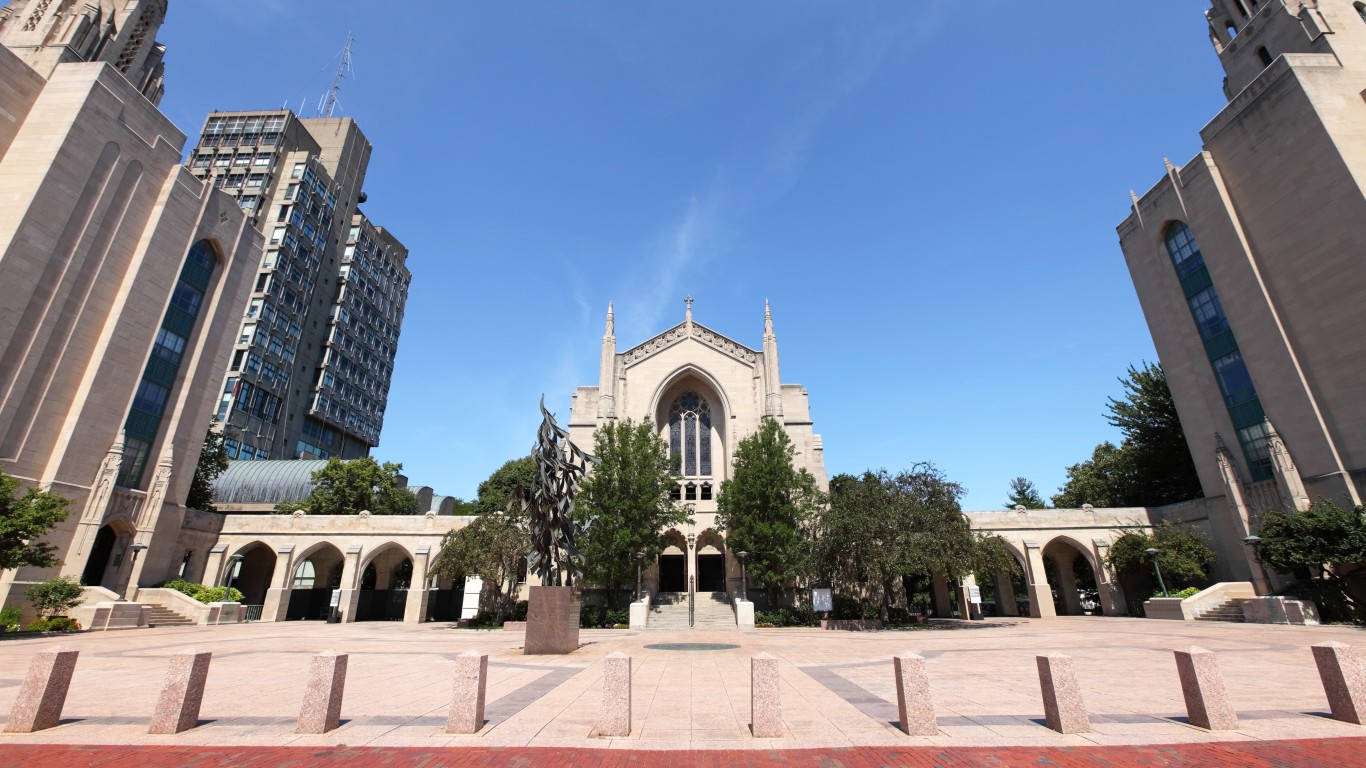
11. Boston University
> Location: Boston, MA
> Avg. annual cost of attendance: $70,216
> Typical earnings 10 yrs. after enrollment: $65,300
> Most popular undergrad major: Business administration, management and operations
At Boston University, more than half of all students associate themselves with the Democratic Party. Comparatively, less than 10% associate with the Republican Party, while 20% consider themselves independent.
Though Boston University is one of the priciest schools in the country, with an average annual cost of attendance of over $70,000, the investment tends to be a good one. Most students who are working and not in school a decade after first entering the university earn over $65,000 per year, nearly double the comparable earnings nationwide.
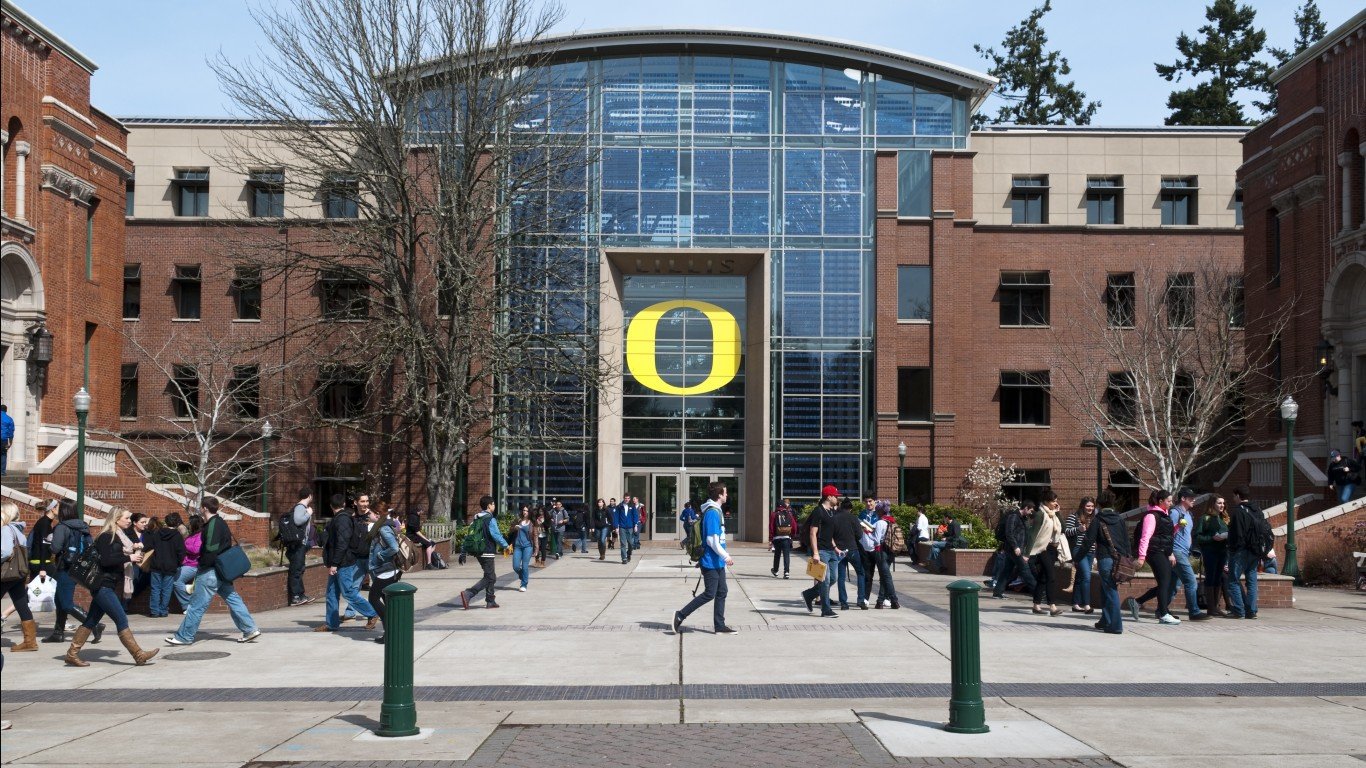
10. University of Oregon
> Location: Eugene, OR
> Avg. annual cost of attendance: $25,126
> Typical earnings 10 yrs. after enrollment: $44,800
> Most popular undergrad major: Business/commerce, general
Students at the University of Oregon broadly agree that the overall political beliefs at the campus skew left. According to a Niche survey, 77% of students feel the campus is either liberal or very liberal. Just 2% say the campus is conservative.
Many of the schools on this list are very small and very selective liberal arts institutions. Yet the University of Oregon is a large state school with an acceptance rate of over 81%. It is also one of the less expensive schools on this list, with an average annual cost of attendance of just over $25,000.
[in-text-ad]
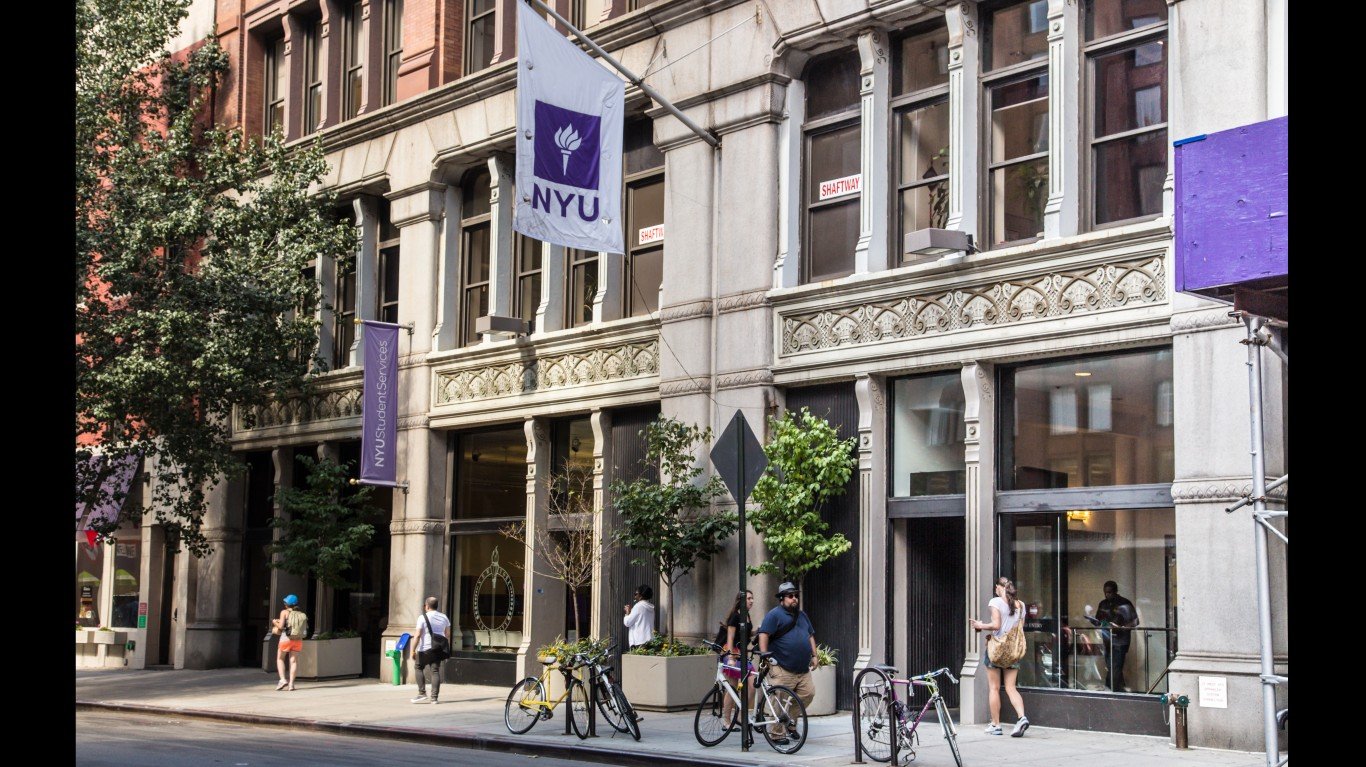
9. New York University
> Location: New York, NY
> Avg. annual cost of attendance: $69,830
> Typical earnings 10 yrs. after enrollment: $61,900
> Most popular undergrad major: Liberal arts and sciences, general studies and humanities
New York University is one of the 10 most liberal college campuses in the country, according to a Niche survey, with 80% of students describing political beliefs on campus as either liberal or very liberal. None described the campus as conservative.
The student body at NYU is racially diverse, with 28.1% of students identifying as white alone, 15.1% identify as being Hispanic, 18.9% as Asian, and 7.2% as black. Also, the school is very popular with students from overseas. More than 20% of the 25,000 students enrolled are not U.S. residents.

8. Independence University
> Location: Salt Lake City, UT
> Avg. annual cost of attendance: $32,820
> Typical earnings 10 yrs. after enrollment: $28,800
> Most popular undergrad major: Business administration, management and operations
Many of Independence University’s students attend classes online, though the school has a campus in Utah.
Generally, the most liberal colleges reflect the leftward slant of the states around them. But this is not the case with Independence University. Located in Salt lake City, Utah, Independence University is one of just two schools on this list located in a state that Trump won in the 2020 presidential election.
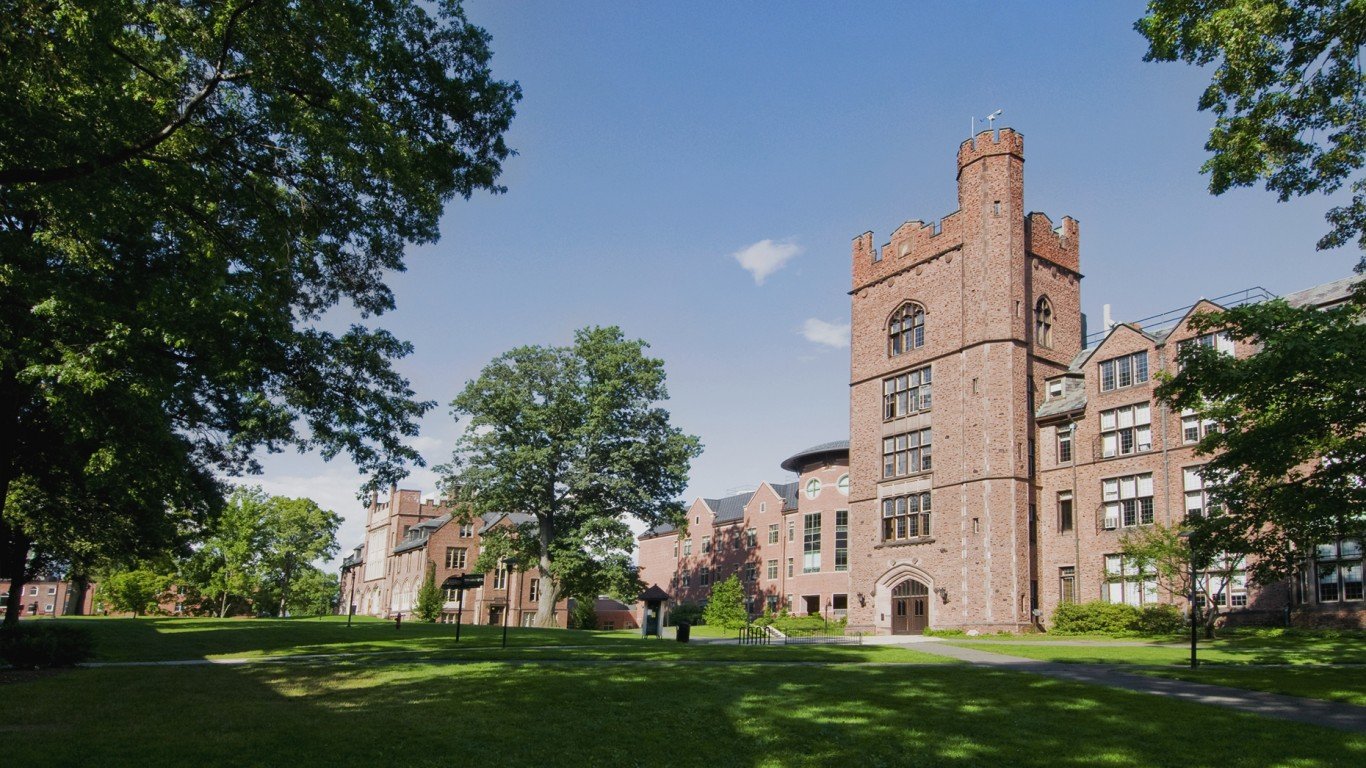
7. Mount Holyoke College
> Location: South Hadley, MA
> Avg. annual cost of attendance: $63,810
> Typical earnings 10 yrs. after enrollment: $48,600
> Most popular undergrad major: Economics
Nearly one-third of Mount Holyoke College students say the campus’s political beliefs are liberal, while more than half describe it as progressive or very liberal. It is one of the Seven Sisters Colleges, prestigious institutions that aimed to make education more equitable for women at a time female students were not allowed in Ivy League schools. Three of these institutions rank on this list.
Similar to six other schools on this list, Mount Holyoke College’s most common major is economics. The school is especially popular among foreign students, as more than 27% of the student body is made up of non-U.S. residents.
[in-text-ad-2]
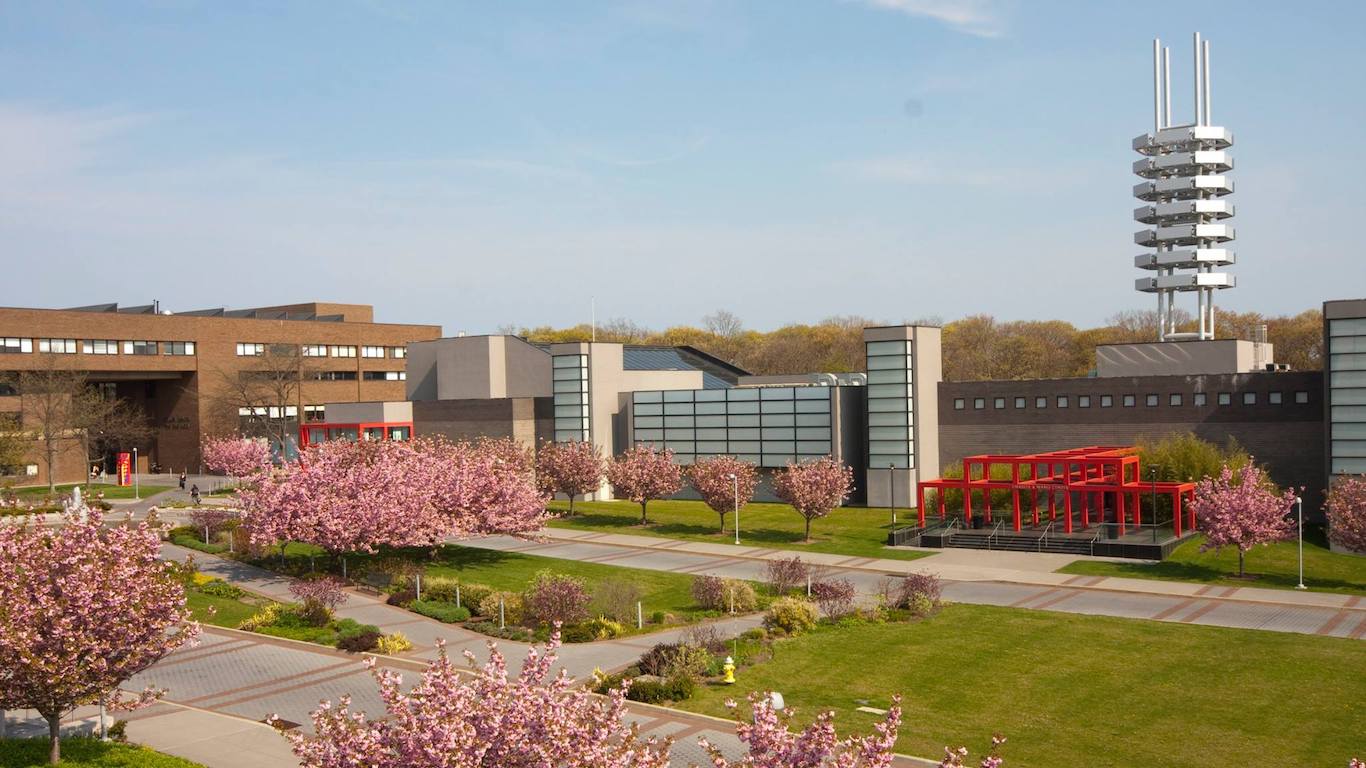
6. Stony Brook University
> Location: Stony Brook, NY
> Avg. annual cost of attendance: $24,718
> Typical earnings 10 yrs. after enrollment: $57,600
> Most popular undergrad major: Health services/allied health/health sciences, general
Stony Brook University is a public research institution located on Long Island in New York. In a Niche survey, 42% of students associated themselves with the Democratic Party, six times the 7% of school students who associated themselves with the Republican Party. Nearly a quarter of students said they were independent, and 22% were not interested in politics.
Stony Brook University stands out as relatively affordable, compared to many other schools that rank among the most liberal in the country. The average student pays less than $25,000 to attend. While this is higher than most U.S. colleges, it is less than half the cost of attendance at many other schools on this list.
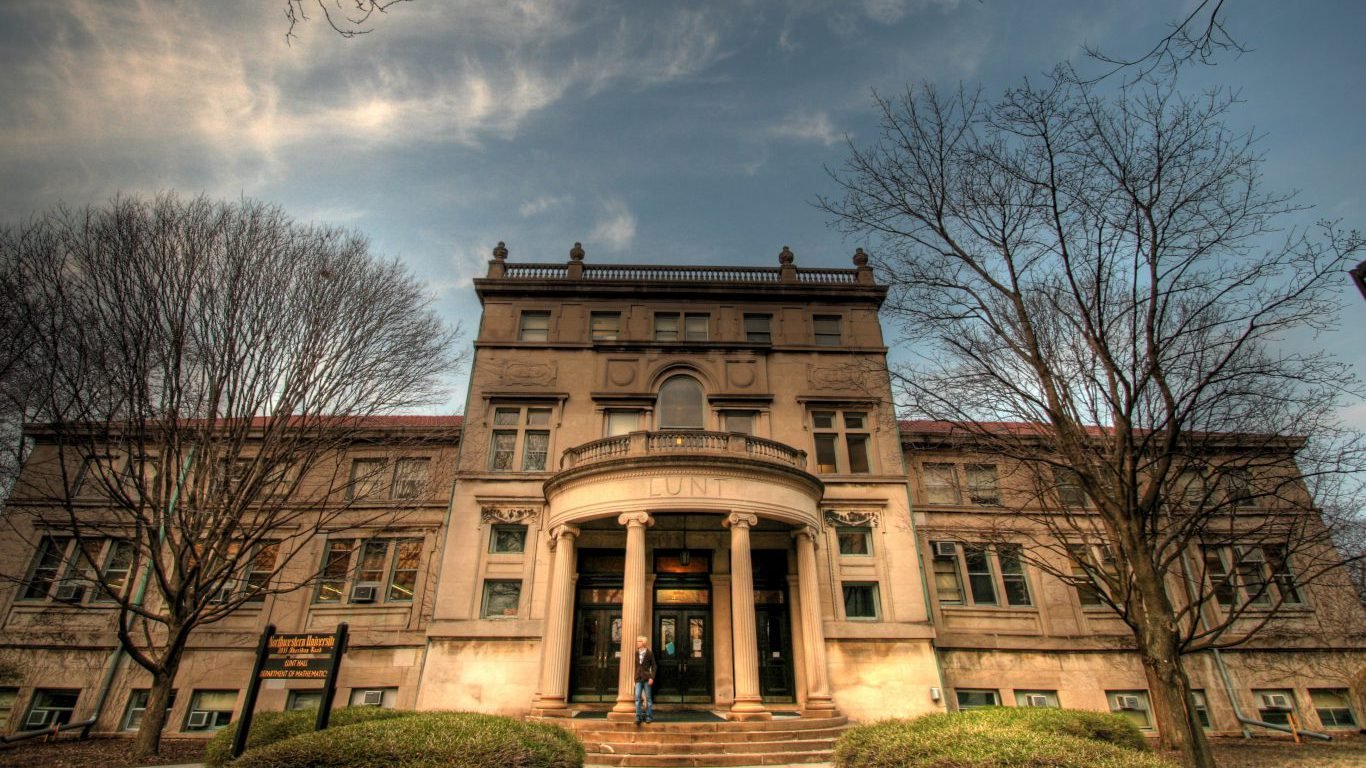
5. Northwestern University
> Location: Evanston, IL
> Avg. annual cost of attendance: $72,960
> Typical earnings 10 yrs. after enrollment: $69,000
> Most popular undergrad major: Economics
The vast majority of students at Northwestern University in Evanston, Illinois, consider themselves liberal. Some 69% of students associate themselves with the Democratic Party, compared with just 3% who associate themselves with the Republican Party.
The colleges on this list tend to be very selective, with most admitting much less than half of all applicants — and Northwestern is no exception. The school received over 40,000 applications for the 2019 school year and accepted less than 3,700 — a 9.1% admissions rate. This makes Northwestern not just the most selective school on this list, but one of the most selective in the country.
[in-text-ad]
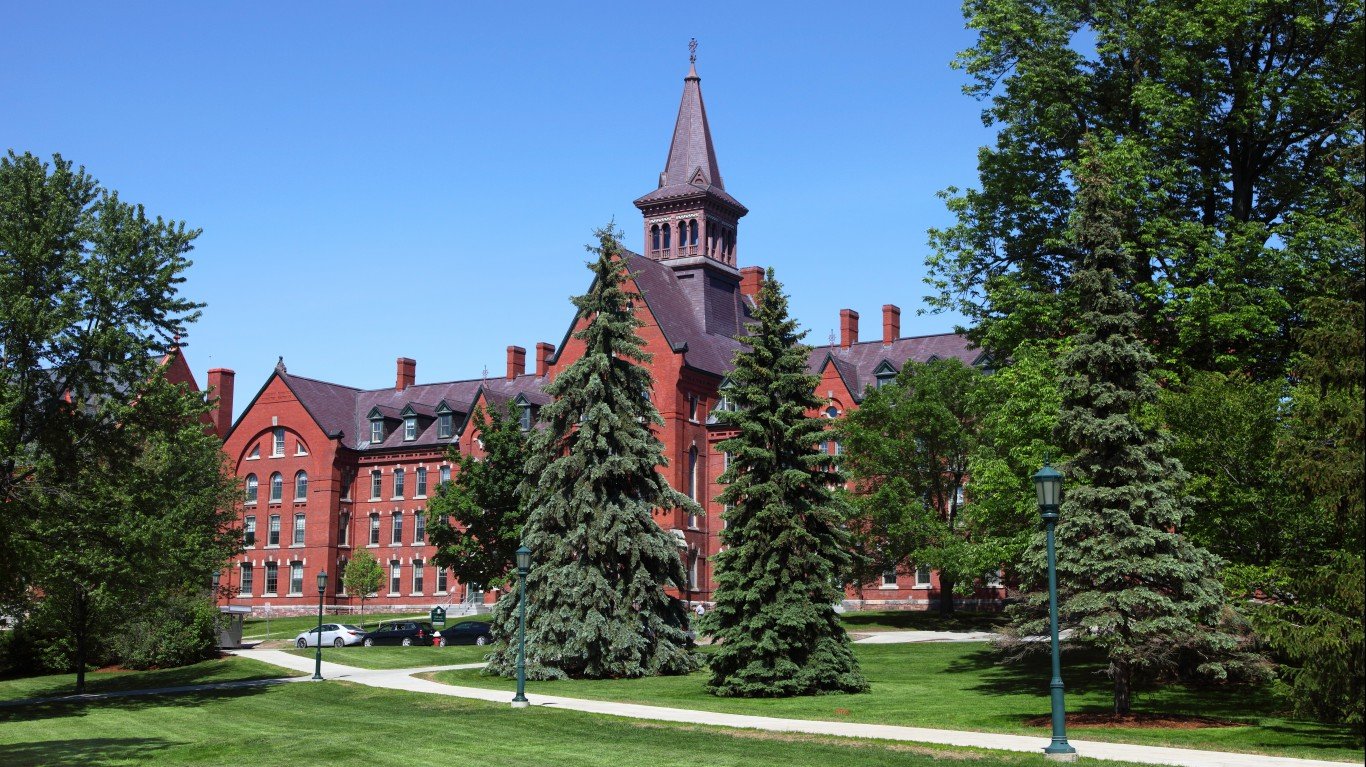
4. University of Vermont
> Location: Burlington, VT
> Avg. annual cost of attendance: $32,825
> Typical earnings 10 yrs. after enrollment: $47,300
> Most popular undergrad major: Business administration, management and operations
Most students at the University of Vermont feel that the overall political beliefs on campus lean far to the left. According to a Niche survey, 51% say the campus is very liberal, and 37% say it is liberal. Just 4% say it is moderate and 1% say it is conservative.
Unlike most other schools on this list, the University of Vermont does not have an especially diverse student body. Neatly 82% of all students identify as white alone, and less than 5% of students are from overseas.
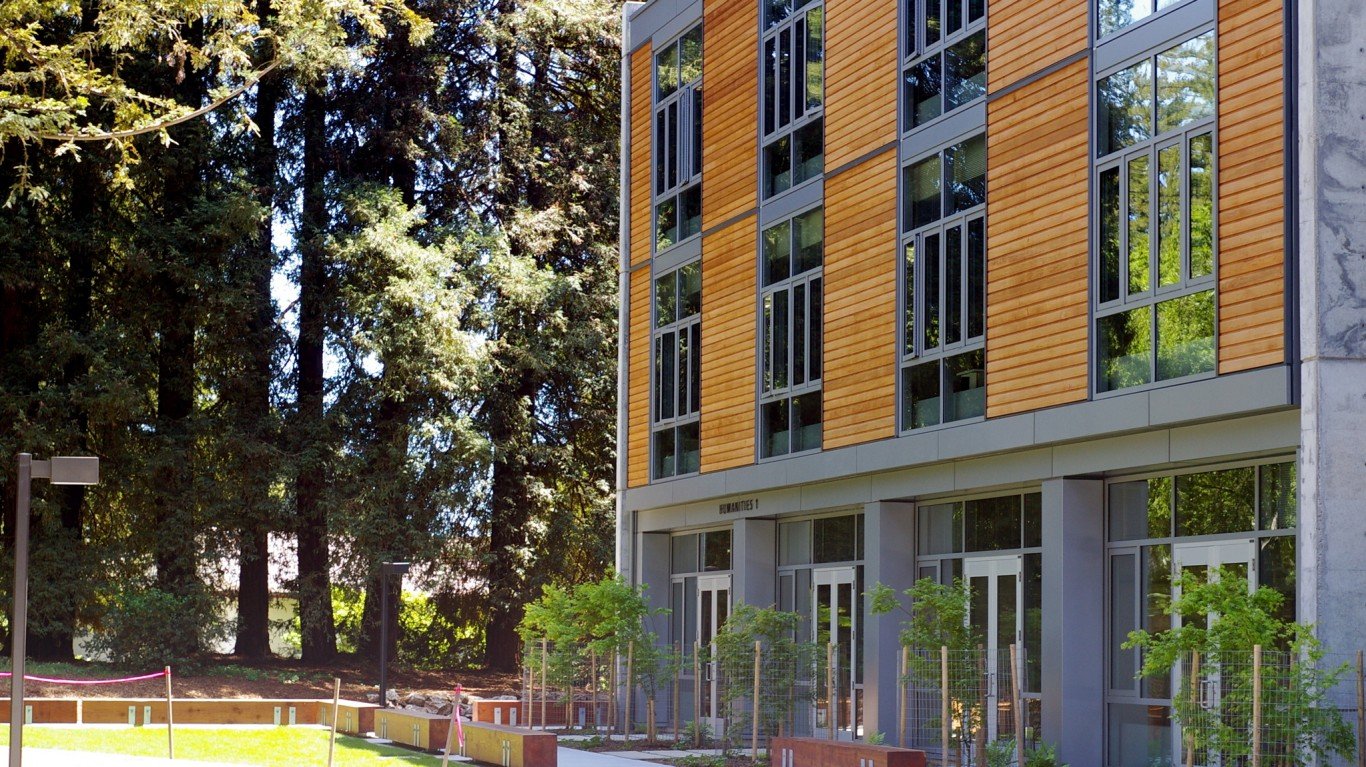
3. University of California-Santa Cruz
> Location: Santa Cruz, CA
> Avg. annual cost of attendance: $35,982
> Typical earnings 10 yrs. after enrollment: $46,900
> Most popular undergrad major: Psychology, general
University of California-Santa Cruz is one of just a handful of large, public schools to rank among the most liberal colleges in the country. With enrollment of over 17,500, it is one of the largest institutions on this list.
More than 80% of students at University of California-Santa Cruz feel that the overall campus political beliefs are either liberal or very liberal, according to a Niche survey. The school is relatively diverse, as 30.4% of students identify as white, 27.6% identify as Hispanic, and 22.3% as Asian
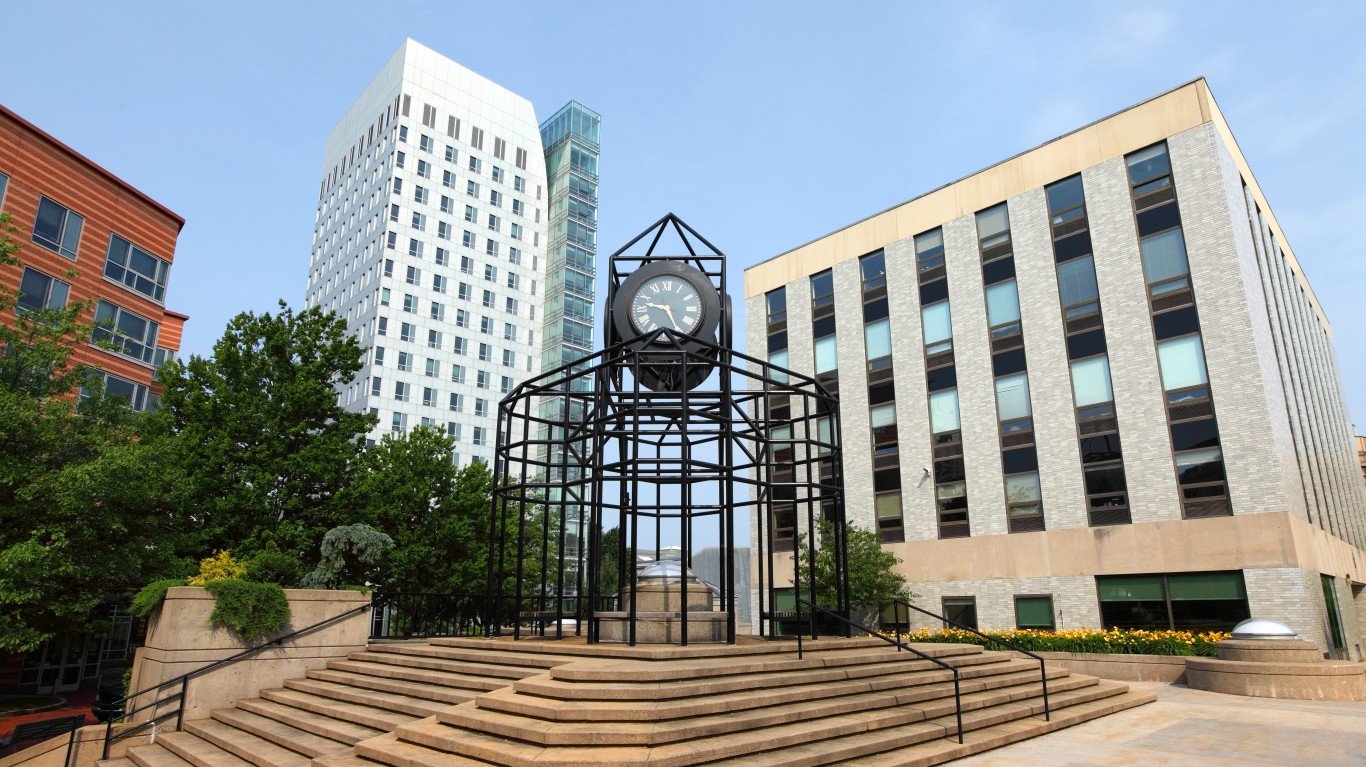
2. Northeastern University
> Location: Boston, MA
> Avg. annual cost of attendance: $67,894
> Typical earnings 10 yrs. after enrollment: $67,400
> Most popular undergrad major: Business/commerce, general
Northeastern University, located in Boston, is one of the most liberal colleges in the entire country. According to Niche, 57% of students associate themselves with the Dmocratic Party, compared to just 5% who consider themselves to be Republicans.
Northeastern has produced a number of well-known Democratic politicians, including Maggie Hassan, a former New Hampshire governor and current U.S. senator, as well as John Pastore, a former senator and governor for Rhode Island.
[in-text-ad-2]
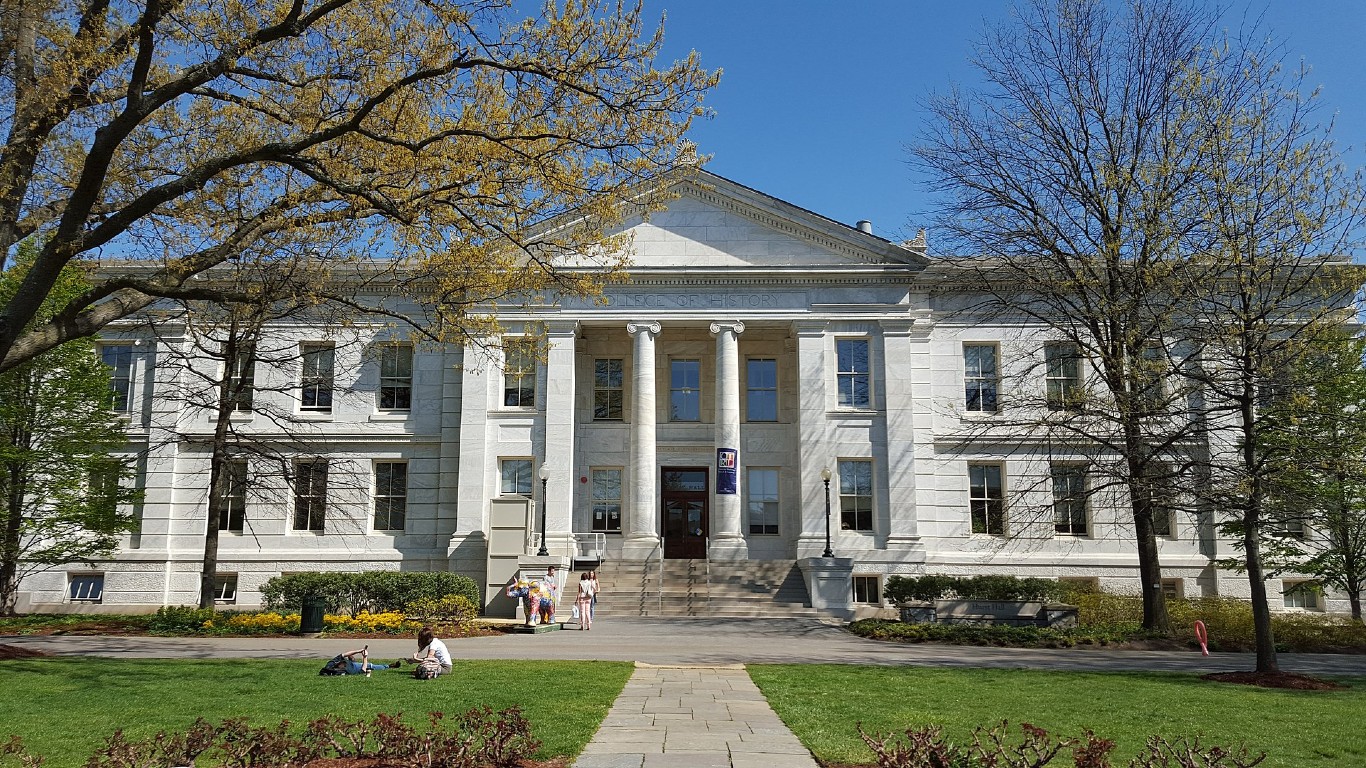
1. American University
> Location: Washington, DC
> Avg. annual cost of attendance: $64,040
> Typical earnings 10 yrs. after enrollment: $61,000
> Most popular undergrad major: International relations and national security studies
No school in America is more liberal than American University, a private research university located in Washington, D.C., according to Niche. Among students using the site, 86% feel the political beliefs of campus as a whole are either liberal or very liberal. Just 12% of students associate themselves with the Republican Party.
American University has a long list of alumni who are notable for their political contributions, including Washington, D.C. Mayor Muriel Bowser and former New Mexico Gov. Toney Anaya, both Democrats.
Methodology
To determine the most liberal colleges in America, 24/7 Wall St. reviewed data from education data clearinghouse Niche’s “2021 Most Liberal Colleges in America” list. Niche’s ranking is based on student surveys about both personal political leanings as well as opinions about the political leanings of other students.
Data on undergraduate enrollment came from the U.S. Department of Education’s Integrated Postsecondary Education Data System and is for fall 2019. Data on the median earnings of individuals who entered university in the 2004-05 academic year and were employed 10 years later also came from IPEDS as is data on the average annual cost of attendance for the 2017-18 school year. Data on the popularity of undergraduate majors is based on IPEDS data on the number of federal loan borrowers who graduated with a degree in that major in the 2015-16 and 2016-17 school years.
Sponsored: Find a Qualified Financial Advisor
Finding a qualified financial advisor doesn’t have to be hard. SmartAsset’s free tool matches you with up to 3 fiduciary financial advisors in your area in 5 minutes. Each advisor has been vetted by SmartAsset and is held to a fiduciary standard to act in your best interests. If you’re ready to be matched with local advisors that can help you achieve your financial goals, get started now.
Thank you for reading! Have some feedback for us?
Contact the 24/7 Wall St. editorial team.
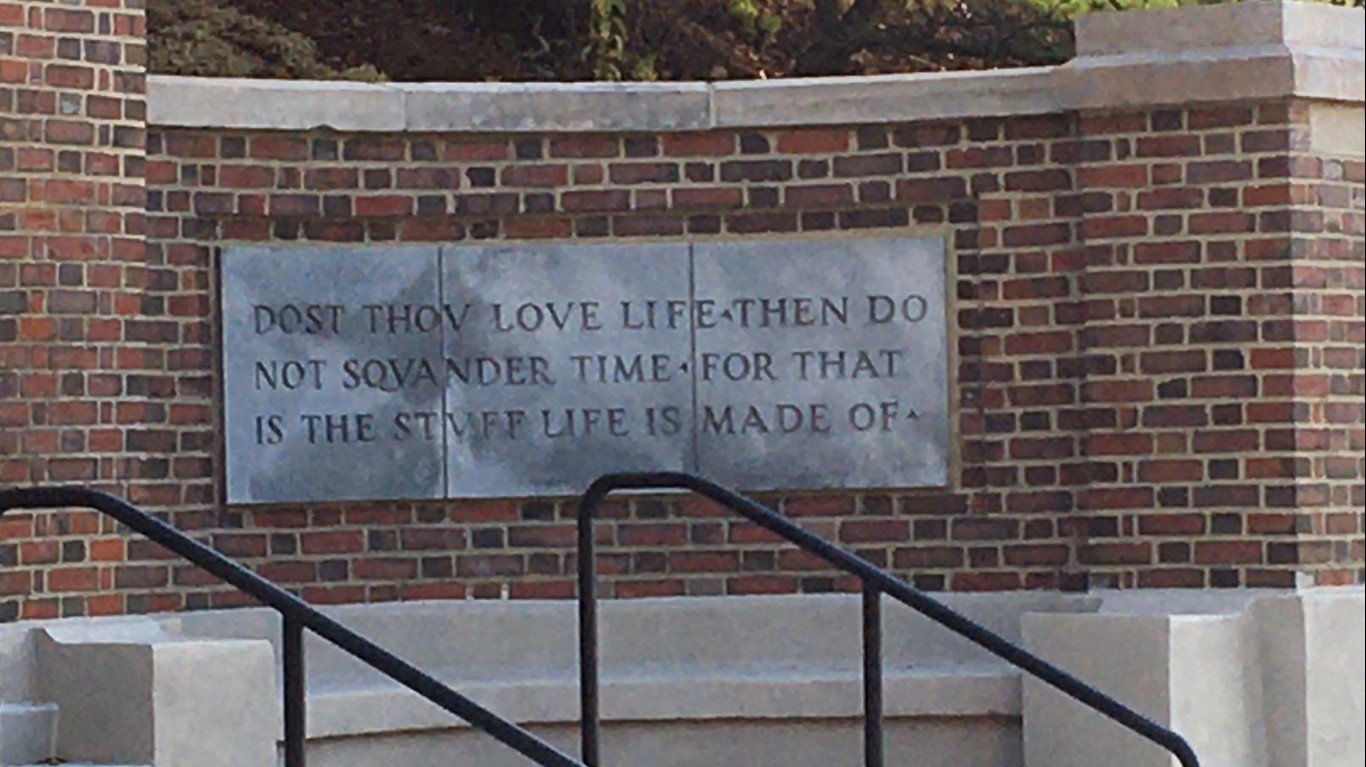
 24/7 Wall St.
24/7 Wall St.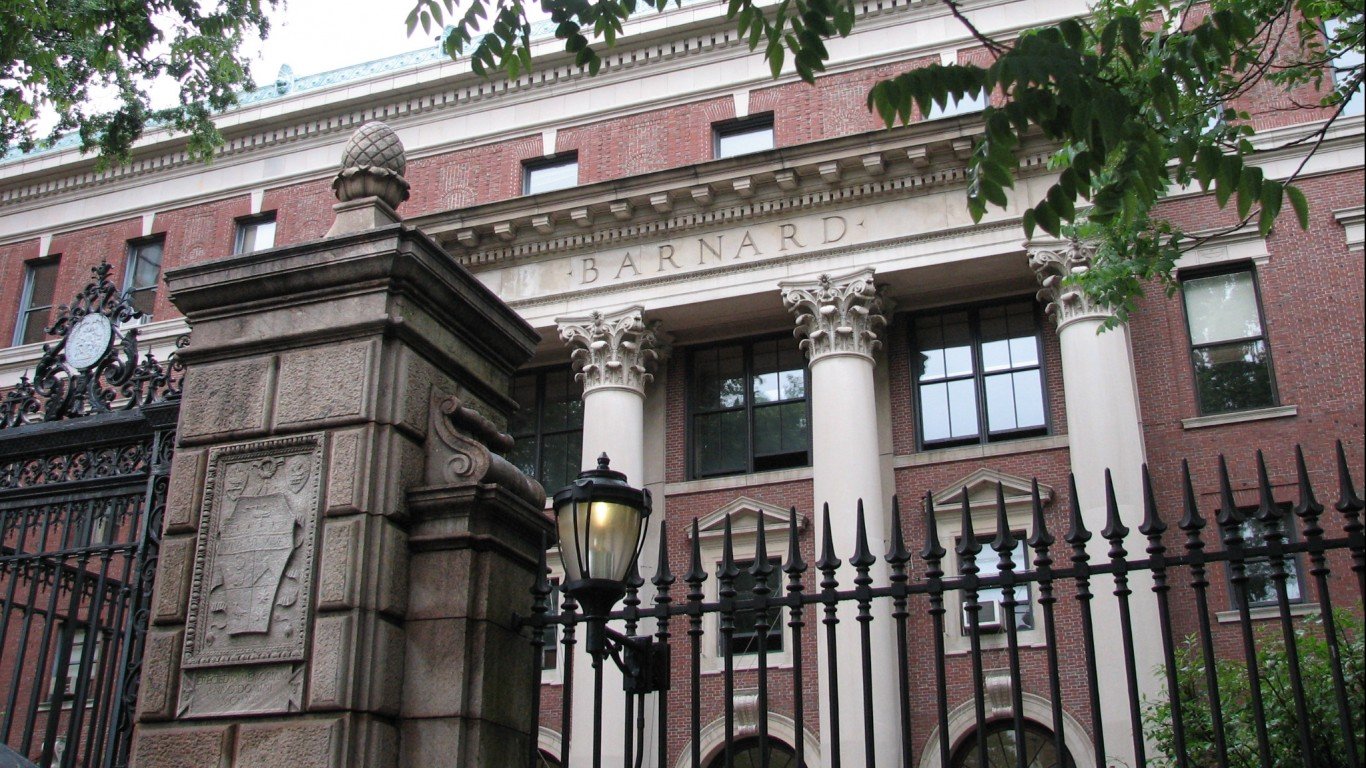
 24/7 Wall St.
24/7 Wall St.
